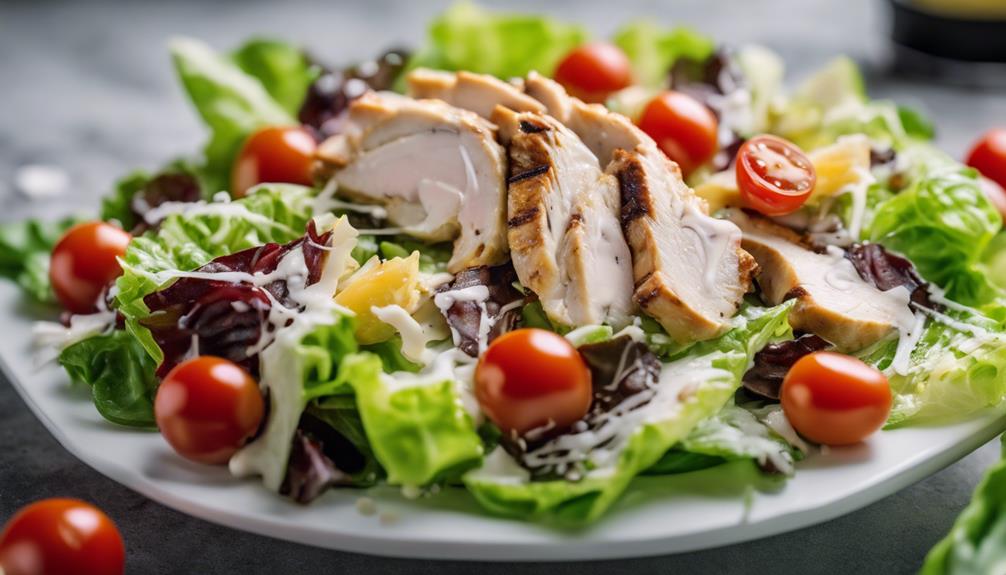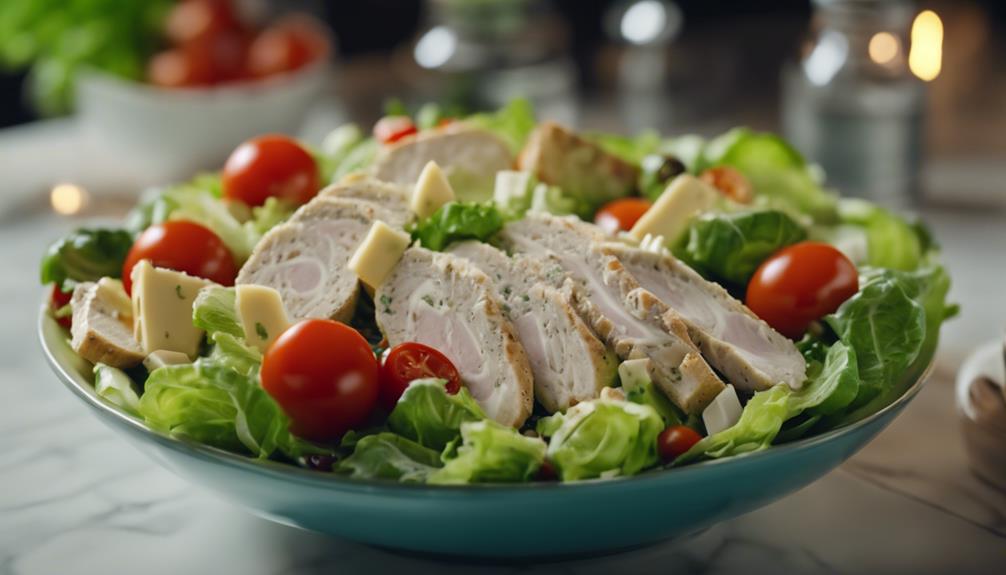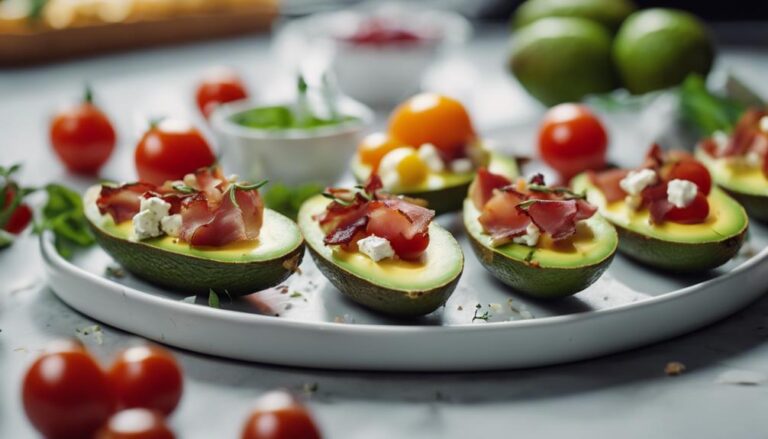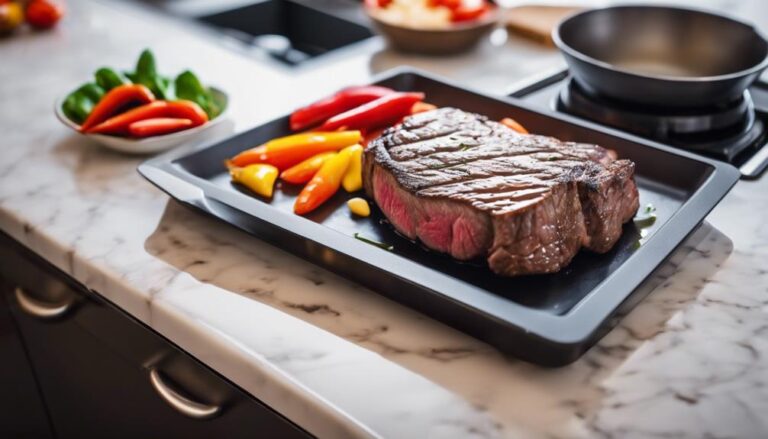Lazy Keto Salad Sous Vide Caesar Salad With Grilled Chicken
Indulge in a lazy keto twist on the classic Caesar salad. Try a sous vide Caesar salad topped with juicy grilled chicken for a flavorful and low-carb meal option. The original Caesar salad, created by Caesar Cardini in the 1920s, includes romaine lettuce, Parmesan cheese, croutons, anchovies, Caesar dressing, and lemon juice. Modify with grilled chicken for a keto-friendly alternative. Experiment with kale or spinach bases and season with black pepper and garlic powder. Elevate your salad game with this fresh and easy recipe. Discover more variations to tantalize your taste buds.
What You Will Learn Here
- Lazy keto salad recipe combines easy preparation with low-carb ingredients.
- Sous Vide Caesar Salad method ensures tender chicken with flavorful seasoning.
- Grilled chicken adds a smoky char and protein boost to the classic salad.
- Embrace keto-friendly options like grilled chicken instead of croutons.
- Customize with Caesar dressing, Parmesan cheese, and fresh greens for a satisfying meal.
Origin of Caesar Salad

Let's explore the intriguing history of the Caesar Salad.
Created by Caesar Cardini, this classic dish boasts a delightful combination of ingredients that have stood the test of time.
Understanding the origins of this beloved salad can add a new layer of appreciation to your culinary experience.
Caesar Salad History
Ever wondered about the intriguing origins of the famous Caesar Salad?
The Caesar Salad has a fascinating history that dates back to the 1920s. Created in Tijuana, Mexico, the salad's origins are attributed to Caesar Cardini, an Italian immigrant and chef. The Caesar Salad has evolved over the years, starting as a simple combination of romaine lettuce, croutons, Parmesan cheese, olive oil, raw egg, and Worcestershire sauce.
Initially, the Caesar Salad was meant to be a dramatic tableside dish, where the dressing was prepared right in front of the diners. This interactive element added flair to the dining experience and quickly gained popularity. Over time, variations of the original recipe emerged, with additions like anchovies, lemon juice, and Dijon mustard becoming common.
The evolution of the Caesar Salad has transformed it from a regional specialty to a beloved classic found on menus worldwide. Its simplicity, yet bold flavors, continue to captivate taste buds and make it a timeless favorite.
Inventor: Caesar Cardini
Caesar Cardini, an Italian immigrant and chef, is credited with inventing the iconic Caesar Salad in the 1920s in Tijuana, Mexico. Cardini created this renowned dish at his restaurant, Caesar's, where he improvised the salad using ingredients readily available in his kitchen.
The key component that distinguishes a Caesar Salad is its unique salad dressing. Cardini's original recipe for the dressing consisted of simple yet flavorful ingredients like olive oil, lemon juice, garlic, Worcestershire sauce, and Parmesan cheese. This classic dressing has since become a staple in Caesar Salads worldwide, loved for its tangy and creamy taste that perfectly complements the crisp lettuce and crunchy croutons.
Caesar Cardini's innovative creation quickly gained popularity, leading to the widespread adoption of his namesake salad across the globe. Today, the Caesar Salad remains a favorite for many, thanks to Cardini's culinary ingenuity and the delicious combination of flavors in the salad dressing he crafted.
Classic Ingredients Combination
The classic combination of ingredients in the Caesar Salad dates back to the 1920s when Caesar Cardini crafted his signature dressing at his restaurant in Tijuana, Mexico. This timeless blend includes crisp romaine lettuce, tangy Parmesan cheese, crunchy croutons, savory anchovies, creamy Caesar dressing, and a hint of lemon juice.
To make this traditional salad keto-friendly, you can opt for grilled chicken instead of croutons to add protein and flavor without the carbs. For those looking to make ingredient substitutions, try using kale or spinach as a base for a different twist on the classic Caesar Salad.
When it comes to salad seasoning, a generous sprinkle of freshly ground black pepper and a touch of garlic powder can elevate the flavors of this dish. Remember that presentation is key, so toss the salad gently to make sure each leaf is coated in the delicious dressing before serving it up with a sprinkle of Parmesan on top for that final touch of elegance.
Key Salad Dressing Components
Consider incorporating a variety of flavorful ingredients like olive oil, vinegar, herbs, and spices to create a delicious keto salad dressing. To elevate your salad dressing game, here are some key components to contemplate:
- Extra Virgin Olive Oil: Use high-quality olive oil for its rich flavor and healthy fats that will add depth to your dressing.
- Balsamic Vinegar: Add a tangy sweetness to your dressing with balsamic vinegar, balancing the flavors in your salad.
- Fresh Herbs and Spices: Incorporate fresh herbs like basil, parsley, or cilantro along with spices such as garlic, mustard, or black pepper to enhance the taste profile of your keto dressing.
Top Caesar Salad Variations

Discover exciting variations of the classic Caesar salad with unique twists like a Sous Vide Caesar Salad or a Grilled Chicken Caesar Salad.
These innovative takes on the traditional recipe add a new dimension to this beloved dish, offering a fresh and flavorful approach to enjoying a Caesar salad.
Whether you're looking to elevate your salad game or simply try something new, these Caesar salad variations are sure to impress your taste buds.
Unique Caesar Salad Twist
Try out a creative spin on the classic Caesar salad with these top variations.
- Grilled Veggie Caesar Salad: Roasted bell peppers, zucchini, and cherry tomatoes bring a burst of flavor to this classic dish. The charred veggies add a smoky element that pairs perfectly with the creamy Caesar dressing.
- Crispy Chickpea Caesar Salad: For a healthy twist, swap out croutons for crispy roasted chickpeas. These protein-packed nuggets add a satisfying crunch to each bite while keeping the salad gluten-free and nutritious.
- Avocado Caesar Salad: Elevate your Caesar salad with slices of creamy avocado. The buttery texture of the avocado complements the tangy dressing, creating a deliciously rich flavor profile that will leave you craving more.
These creative salad variations offer a culinary innovation that revamps the traditional Caesar salad, making it a versatile and exciting option for any meal.
Whether you're looking for an easy meal prep idea or a healthy twist on a classic favorite, these unique twists are sure to impress your taste buds.
Sous Vide Caesar Salad
Elevate your Caesar salad experience with a modern twist by exploring the innovative world of Sous Vide Caesar Salad. This keto-friendly variation brings a new level of tenderness and flavor to your favorite classic dish.
Here are three ways to enjoy this delightful creation:
- Sous Vide Cooking Technique: Discover the art of sous vide, where ingredients are vacuum-sealed and cooked to perfection in a water bath. This method guarantees your chicken is juicy and packed with flavor, elevating your Caesar salad to a whole new level.
- Customized Dressing Options: Experiment with keto-friendly dressing variations to suit your taste buds. From creamy avocado Caesar to tangy lemon garlic, there are endless possibilities to enhance the flavors of your sous vide Caesar salad.
- Creative Toppings: Add a crunchy twist to your salad with keto-friendly toppings like toasted nuts, crispy bacon, or Parmesan crisps. These additions provide texture and depth to each bite, making your sous vide Caesar salad a memorable dining experience.
Grilled Chicken Caesar Salad
Enhance your Caesar salad experience with the smoky flavors of a Grilled Chicken Caesar Salad, a popular variation that adds a delicious twist to this classic dish.
When preparing a Grilled Chicken Caesar Salad, consider the following to elevate your salad presentation:
- Grilled Chicken: Marinate the chicken in a savory blend of herbs and spices before grilling to perfection. This adds a juicy and flavorful protein element to your salad.
- Fresh Greens: Use a mix of crispy romaine lettuce and other leafy greens to create a vibrant base for your salad. This combination adds texture and visual appeal to your dish.
- Homemade Dressing: Create a creamy Caesar dressing from scratch using ingredients like anchovies, garlic, Parmesan cheese, and lemon juice. Drizzle this velvety dressing generously over your salad for an authentic flavor profile.
Salad Dressing Emulsification Techniques
When making salad dressings, understanding the basics of emulsification is key.
You'll often find recipes that call for a mixture of oil and vinegar, which need to be properly combined to create a stable emulsion.
Whether you choose to use a blender or a whisk, the goal is to evenly disperse the oil into the vinegar for a smooth and cohesive dressing.
Emulsification Basics
Understanding the basics of emulsification is key to mastering salad dressing techniques. When it comes to oil blending, the goal is to create a vital mixture by combining oil with other ingredients like vinegar or lemon juice. This process involves breaking down the oil into tiny droplets that disperse evenly throughout the dressing.
One common method to achieve this is by gradually adding the oil to the other ingredients while whisking vigorously or using a blender to create a smooth and creamy texture.
Salad tossing also plays an essential role in emulsification. By tossing the salad ingredients with the dressing, you make sure that each component is well-coated, allowing the flavors to meld together harmoniously. The tossing action helps distribute the oil evenly over the greens and other elements, enhancing the overall taste of the salad.
Remember to toss gently to avoid crushing delicate ingredients and maintain the integrity of the dish. Mastering these emulsification basics will elevate your salad dressing game and impress those you serve.
Oil and Vinegar
To achieve a well-emulsified salad dressing using oil and vinegar, start by slowly drizzling the oil into the vinegar while whisking vigorously. This technique allows the oil droplets to disperse evenly throughout the vinegar, creating a smooth and creamy texture that enhances the flavor of your salads, marinades, and sauces.
Oil and vinegar are vital components in various cooking techniques, offering a simple yet flavorful way to elevate your dishes.
Salad dressings made with oil and vinegar can be customized with herbs, spices, or sweeteners to suit your taste preferences. The balance between the oil and vinegar is essential for a harmonious blend that enhances the overall dish.
Whether you're preparing a classic vinaigrette or experimenting with new flavor combinations, mastering the art of emulsifying oil and vinegar is a valuable skill in the kitchen.
Incorporating oil and vinegar in your cooking repertoire opens up a world of possibilities, allowing you to create delicious and versatile dressings, marinades, and sauces that will impress your family and guests.
Experimenting with different types of oil and vinegar can lead to exciting culinary discoveries and add a touch of creativity to your meals.
Blender Vs. Whisk
For achieving a well-emulsified salad dressing using oil and vinegar, considering whether to use a blender or a whisk can greatly impact the outcome. Both the blender and whisk are effective tools for emulsification, but they work in different ways.
Using a blender is a quick and efficient method for creating a smooth and creamy dressing. The high-speed blades of the blender help to thoroughly mix the oil and vinegar, creating a stable emulsion. This method is ideal for making larger batches of dressing or when you desire a thicker consistency.
On the other hand, using a whisk requires a bit more effort but allows for better control over the emulsification process. Whisking by hand helps incorporate air into the dressing, creating a lighter texture. It's a great option for smaller quantities of dressing or when you prefer a more delicate and airy result.
Ultimately, whether you choose the blender or whisk, both methods can yield delicious and well-emulsified salad dressings. Experiment with both techniques to find which one suits your preferences best.
Final Thoughts

Consider incorporating this lazy keto salad into your meal rotation for a simple and satisfying option.
When it comes to salad presentation, this Caesar salad offers a visually appealing dish with vibrant greens, the golden-brown hues of grilled chicken, and the creamy drizzle of Caesar dressing.
The flavor profiles of the salad are well-balanced, blending the richness of Parmesan cheese with the tangy notes of the dressing and the smokiness of the grilled chicken.
For meal pairing, this sous vide Caesar salad with grilled chicken can be served alongside a light soup or a side of roasted vegetables for a wholesome and filling meal.
If you need ingredient substitutions, feel free to customize the salad by swapping the protein with grilled shrimp or tofu for a different twist.
You can also experiment with different types of greens like kale or arugula to cater to your taste preferences.
Frequently Asked Questions
Can I Use Store-Bought Caesar Dressing for This Recipe?
Yes, you can use store-bought dressing for convenience. However, homemade dressings often offer fresher flavors. Grilled protein adds a smoky taste, while roasted protein may have a different texture. Consider your preferences when choosing ingredients.
Can I Substitute Grilled Chicken With Another Protein?
Yes, for protein substitutions, consider options like grilled shrimp, tofu, or salmon. These choices cater to Keto options and various dietary preferences. They offer unique salad variations, allowing you to enjoy a flavorful and satisfying meal.
How Long Does Homemade Caesar Dressing Stay Fresh?
When making homemade Caesar dressing, remember to refrigerate it promptly. Your tasty dressing can last about 1-2 weeks in the fridge. To keep it fresh longer, store it in an airtight container and give it a good shake before serving.
Is It Necessary to Use a Sous Vide Machine for This Salad?
You don't need a sous vide machine for this salad. There are alternative cooking methods like grilling or pan-searing the chicken. Simplify the recipe with quick meal options to enjoy a delicious Caesar salad without the need for specialized equipment.
Can I Make the Caesar Dressing Ahead of Time?
You can definitely make the Caesar dressing ahead of time. It's a great time-saving hack for meal prep. Make ahead tips like this can help you enjoy your meal faster and with less stress.
Conclusion
To sum up, Caesar salad is a classic and versatile dish that can be easily customized to suit different tastes and preferences.
Whether you prefer traditional ingredients or like to mix things up with unique additions, the key to a delicious Caesar salad lies in the perfect balance of flavors and textures.
Experimenting with different salad dressing emulsification techniques can elevate the dish even further, making it a favorite choice for a quick and satisfying meal option.











